
25th
Is NCC really the key to making buildings COVID-safe?
By Graeme McLeish, Senior Consultant
The headline on this recent article published by HVAC&R is an attention arresting one: ‘to pandemic-proof buildings.’ It is a worthy aim, but the reality is more complex than specifying new standards within the construction code (NCC) to address ventilation rates. What gets designed in, does not necessarily translate to real-world application, especially considering the goal of trying to control for airborne pathogens.
In our view, mechanical ventilation is the only way of providing consistently good levels of indoor air quality, and what does not get measured gets forgotten.
Professor Morawska states improving ventilation is a function of multiple elements such as occupancy rates, time spent in, and specific use of the space. All this requires data to be collected to continually assess for changing interior dynamics. Ultimately, this will require both investment and policy decisions to be made, but in the meantime, ‘we need to start somewhere’.
Vince Aherne notes, “The NCC would be an appropriate place to set a requirement, preferably a performance requirement”, as well as updates to technical solutions to Australian Standards. However, this could take years to implement with extensive research required.
Taking a step back from this, QED would recommend implementing continuous monitoring of the built environment, whereby installed sensors can test the air every few minutes and relay the data to a dashboard in real-time.
Such data provides not only for ventilation effectiveness (measured via CO2) but also other pollutants that impact upon infectious aerosols such as particulate matter - airborne pathogens can attach themselves and increase the risk of COVID transmission for instance.
“There are tools now for such calculations,” notes Morawska, but these tools are quite complex, and they require data input.
But first and foremost the right data needs to be gathered and assessed before it is ready for input, and continuous monitoring solutions can provide this.
Categories
Recent Posts
Trichloramine and Indoor Air Quality in Swimming Pools
05th Nov
For swimmers and pool workers alike, the characteristic "chlorine smell" at indoor swimming pools is part of the experience. Howev...
Indoor Air Quality Takes Centre Stage: A New Government Report on Airborne Virus Transmission
30th Sep
The importance of Indoor Air Quality (IAQ) has gained significant attention following the release of a groundbreaking report from Australia‚...
Changes to the workplace exposure standard for welding fumes
15th Mar
On January 18, 2024, SafeWork Australia made a significant adjustment to the Workplace Exposure Standard (WES) for Welding Fume (not otherwi...

















